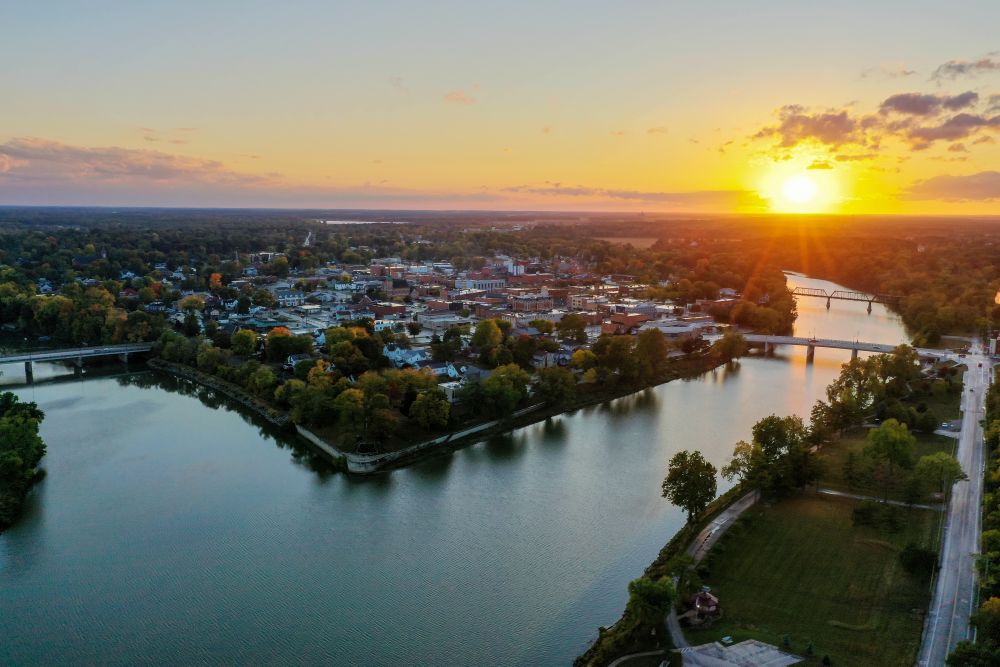
As our nation prepares to celebrate its 250th birthday in 2026, it’s a fitting time to reflect on those stories that played a pivotal role in shaping its growth among these stories, the impact of the canal system here in Defiance, OH. This city’s transformation from a strategic frontier fort to a booming commercial center was intricately linked to the confluence of the Miami and Erie Canal and the Wabash and Erie Canal, becoming the catalyst for economic development, population growth, and regional connectivity in the heart of an emerging nation.
Life Before Canals
In the early 1800s, Ohio was geographically isolated from the eastern states due to the Appalachian Mountains, dirt roads, and trails, which were impassable after rain or snow. Local economies relied heavily on agriculture with limited transportation options, hindering farmers from transporting leftover produce to markets outside their local communities due to the high cost and inefficiencies of available transportation means.

Before the Miami and Erie Canal reached Defiance, life outside agriculture revolved around the fur trade and the military presence at Fort Defiance. The confluence of the Maumee and Auglaize rivers made the area a key trading post for Native Americans and early settlers, with their homes sprouting up along the river.
Despite its early importance, Defiance remained a relatively small and isolated community until the canals began to transform the region.




Canal Construction
The construction of the Miami and Erie Canal and the Wabash and Erie Canal was a monumental undertaking that profoundly transformed Defiance. It involved immense labor, considerable financial investment, and numerous engineering challenges.
Canal construction, particularly in the early 19th century, relied mostly on manual labor. Work crews primarily made up of German and Irish immigrants used picks and shovels to dig the massive trenches by hand. According to the Miami-Erie Canal Corridor Association, teams of horses and oxen were occasionally used to power slip-scoops and pull wagons.
Still, the work was arduous and often dangerous. Workers faced harsh weather conditions, challenging terrain, and the constant threat of disease, particularly malaria and cholera. Safety standards were minimal and many laborers died from accidents or illness all for a low wage, often around 30 cents a day in addition to food, whiskey, and shelter.
Miami and Erie Canal
The Miami and Erie Canal connected the Ohio River with Lake Erie, extending 274 miles from Cincinnati to Toledo. Construction began in Cincinnati in 1825 and reached Defiance in 1843 before its completion in 1845. To overcome the numerous elevation changes along the route, 105 locks were constructed along with 19 aqueducts, several manmade reservoirs, including the Grand Lake St. Mary’s and Lake Loramie and feeder canals to supply the canal with water.
Canal boats were long, low, narrow vessels that averaged 78 feet in length by 14 feet 10 inches wide and were designed to transport freight or passengers. They traveled slowly down the canal, pulled by a team of horses or mules walking on a tow path alongside the canal.
Canal use peaked in the 1840s, but the arrival of trains in the 1850s marked the beginning of the canal’s decline. Railroads offered faster and more efficient transportation, gradually replacing the canal for commercial traffic. A devastating flood in 1913 severely damaged the canal, leading to its permanent abandonment.
Wabash and Erie Canal
The Wabash and Erie Canal was a crucial waterway in 19th-century Indiana and Ohio, connecting Lake Erie at Toledo through Defiance to the Ohio River at Evansville, IN – a massive 468 miles, making it the longest canal in the United States. Construction began in Fort Wayne, IN in 1832, connecting the Wabash and Maumee rivers. The canal traveled through Huntington, Lafayette, and Terre Haute, IN, en route to Evansville and its completion in 1853.
Canal boats traveled down the Wabash and Erie Canal with their own towpath and horsepower, literally. This confluence with the Miami and Erie Canal significantly impacted the economic fortunes for Defiance. But, like the Miami and Erie Canal, the Wabash and Erie Canal suffered the same eventual decline with the proliferation of trains only sooner, as operations ceased around 1870.
Collective Impact
The completion of the canals marked a turning point in the city’s development. Thanks to its location at the confluence of the Maumee and Auglaize rivers, Defiance became a crucial hub of goods and passengers between the canals and rivers, opening access to distant markets and attracting new settlers and businesses.
Canal traffic brought prosperity to the region. Farmers could now afford to ship surplus crops while manufacturing took hold with the ease of transporting raw materials and goods. Local mills and factories diverted canal water to power their operations. In the meantime, Defiance became a hotbed for the lumber and timber trades. Business was booming – or more accurately, flowing – with timber, coal, wheat, flour, iron, and whiskey.
From 1846 – 1880, the city’s population grew from 700 to 5,907. The influx of people and economic activity established Defiance as a major commercial and transportation hub not only in Ohio but the United States, officially transforming it from a frontier settlement into a bustling and prosperous city in the middle of the nation’s budding market economy.
Lasting Legacy
By 1917, the canals in Defiance were gradually drained and filled in, but their legacy continues to be preserved and celebrated in Defiance today. In 1997, Lock #37 of the Miami and Erie Canal was uncovered in downtown Defiance, and a park was established around the partially restored lock. Today, it remains a popular tourist attraction as a part of Canal Park, with an adjacent amphitheater.
Located just northeast of Defiance at Independence Dam State Park, remnants of Lock #13 can be found. It was known as a “guard lock” on the Miami and Erie Canal, which allowed boats to transition from the Maumee River into the canal. Today, visitors can explore the ruins of the canal, including a three-mile hiking trail along the river that was once the canal’s towpath.






